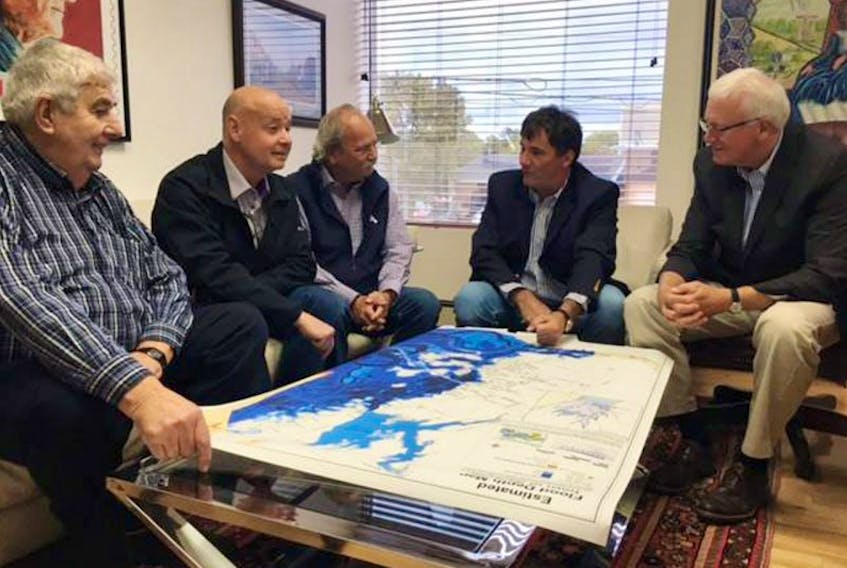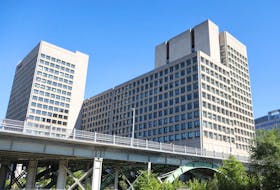The Cumberland-Colchester MP met recently with Beausejour MP Dominic LeBlanc and municipal leaders on both sides of the border to start the process in hopes of upgrading the infrastructure along the marsh to protect highways and the main rail line that connects Halifax with the rest of Canada.
“There have been several studies done that say the dykes are no longer able to hold back the sea and that in a lot of areas the only thing holding back a very high tides is the railway line,” Casey said. “The railway is effectively a dyke now and that is not a safe situation.”
Casey is afraid of what could happen if the railway line were to be compromised by a storm or by rising sea levels. He estimates the losses could be in the millions of dollars.
“The Port of Halifax ships 400,000 containers a year across that rail line to central Canada and the United States. If that rail line were to break the Port of Halifax would be threatened because it wouldn’t be able to get its products to market,” Casey said.
Casey has no idea how much it would cost to repair or replace dykes holding back the Bay of Fundy tides, some of which are the highest in the world. He said it’s time to resurrect the issue and make sure governments at all levels are not only aware of it, but prepare a plan to deal with it before it’s too late.
“This is a big deal. There are maps out there that show what would happen if the dykes were to be overwhelmed,” he said.
Casey and LeBlanc are going to work with federal officials while Casey said he plans to speak to the head of the Port of Halifax and Halifax Mayor Mike Savage to make them aware of the impact on the city.
This isn’t the first time Casey has raised the issue. In 2009, while sitting as an Independent, Casey spoke to former Conservative MP Jim Prentice about a report by the UN Panel on Global Warming that identified the bay and New Orleans as among the most vulnerable places in the world.
Mount Allison professor Dr. Jeff Ollerhead said talking about doing something is far short of actually doing something about rising sea levels and the crumbling infrastructure on the marsh. To him, the threat intensifies every year, but no one wants to do anything about it because of the potential cost.
“The sea level is higher than the last time we talked about this and it’s continuing to rise,” Ollerhead said. “Scientists tend to be conservative and recent information coming out of the United States to explain sea level rise are probably under estimating the rate of sea rise. The latest estimates between now and the end of the century is over two metres.”
Ollerhead said it’s not a question of if the dykes are inundated, but when. He suggests another storm like the Saxby Gale of 1869 is going to happen and there’s no way the infrastructure on the marsh will survive.
“If a storm of that magnitude happened on the spring high tide that water would do a lot of damage,” he said.
He thinks part of what’s holding back repairs to the dykes is the fact it involves two different provinces. Marshlands have been a provincial responsibility for several decades. The other factor is that storms of the magnitude of the Saxby Gale are so infrequent.
“In my time I’ve been out on three separate occasions at Wood Point where the water would have come over the dykes if it had happened at the spring tide,” he said. “The factors didn’t line up, but eventually they will. It’s like Puerto Rico. For 80 years the hurricanes missed Puerto Rico so you get complacent until the day comes when it hits you. Now it’s a huge problem.”
He thinks a strategic plan is required for the dykeland system that could see some newer dykes constructed and older dykes removed.
[email protected]
Twitter: @ADNdarrell
Casey, LeBlanc meet with municipal officials about Fundy sea levels
AMHERST, N.S. – Bill Casey wants to start talking about rising sea levels and their potential impact could be on the dykes and aboiteaus between Amherst and Sackville, N.B.

STORY CONTINUES BELOW THESE SALTWIRE VIDEOS
Prices at the Pumps - April 17, 2024 #saltwire #energymarkets #pricesatthepumps #gasprices








